The best LED desk lamp
After testing 15 models, these are your best three choices.

By Anna Perling
This post was done in partnership with Wirecutter. When readers choose to buy Wirecutter's independently chosen editorial picks, Wirecutter and Engadget may earn affiliate commission. Read the full LED desk lamp guide here.
After consulting lighting and optometry experts, and spending 32 hours researching more than 40 desk lamps and testing 15, we think that the TaoTronics LED Eye-caring Table Lamp (TT-DL13) is the best lamp for most tasks that require focused light. It has the most brightness levels, color temperatures, and adjustability for customizing your lighting, and its light panel has the least glare.
The TaoTronics LED Eye-caring Desk Lamp (TT-DL13) has seven brightness levels, with the top level more than bright enough for typical desk tasks; yet no matter how you position the lamp, its frosted panel prevents glare—other, pricier lamps created annoying reflections or bright points of light. It also has one of the most intuitive control panels we've seen, and its slim, unassuming shape looks good on a desk or a nightstand.
The Fully Lumen LED Desk Lamp is virtually identical to our top pick—the only difference besides branding is that the Fully weighs a half pound more. But it's more than double the price of our top pick when purchased on its own. It's half off when bought with our pick for the best standing desk, so if you plan to buy both, we recommend buying the lamp from Fully for a one-stop shopping experience.
If you're not picky about controlling brightness and color temperature, the IKEA Forså is a classic architect-style lamp with a replaceable bulb that you can swap if you want a different light temperature or color. It's also the most adjustable lamp we tested, and it's available in more colors. Its classic style may work better with different design schemes if you're not into the sleek, modern look of most LED desk lamps.
Why you should trust me
To research this guide, I learned more than I ever thought I'd need to know about LEDs—the industry standards for measuring bulb longevity, their energy-saving abilities, and how they affect eye health. That included reading sections of the Illuminating Engineering Society's American National Standard Practice for Office Lighting and the Nonresidential Lighting and Electrical Power Distribution (PDF) guide by the California Lighting Technology Center at UC Davis and calling the Energy Trust of Oregon to try to figure out how much money LEDs really save.
To determine the features that make the best LED desk lamps, I interviewed five experts: Geoff Goral, senior designer at the Lighting Design Alliance; Linnaea Tillett, head of Tillett Lighting Design Associates; Nicole Graeber, a development engineer at the California Lighting Technology Center at the University of California, Davis; Dr. Gregory Good, professor emeritus of clinical optometry at The Ohio State University College of Optometry; Mark Lien, industry relations manager of the Illuminating Engineering Society; and Wirecutter's own lighting enthusiast, editor Dan Koeppel.
Who should buy this
Desk lamps are frequently called "task lamps," because they supplement overhead lighting to help you better see what you're working on—whether that's reading, cooking, sewing, drawing, or writing. "A general lighting scheme doesn't address itself to the tasks that you perform in your space ... a task light allows you to focus your perception on what you're doing," said lighting designer Linnaea Tillett, founder of Tillett Lighting Design Associates.
Another benefit of job-specific lighting is that having multiple adjustable lamps in your workspace reduces the contrast between the object you are focused on and the surrounding area. As Tillett explained, "When you reduce contrast, it's relaxing for your eye and keeps you from changing your focal perspective."
You can use a task lamp to customize your lighting situation to suit your mood or match the time of day, something you can't do with traditional overhead lighting alone. Most of the LED lamps we considered let you adjust color temperature (a measurement that describes the actual color of the light you're working with). For example, if you work late you may prefer using warmer, golden light (there is some evidence that blue light can affect circadian rhythms and melatonin production, the latter of which can help you sleep). Conversely, "Cooler color temperatures in a work environment give the perception of 'brighter' light and can help keep people alert," according to Geoff Goral of the Lighting Design Alliance. Age, eye health, time of day, and work space can also affect color-temperature preferences as well. Ideally, a good lamp should give you options.
Task lights also let you tweak the position of your light source. "A lot of people work in an office space and don't have the option to dim, move, or manipulate the lights on the ceiling," Goral said. "With a desk lamp, they can orient it to fit their task ... that helps productivity and mood." With adjustable task lights, overall light can be dimmer, which can save energy (and money) according to our experts.
Compared with incandescent, halogen, or compact fluorescent (CFL) bulbs, LED lamps are cheaper and better for the environment. Most of the lamps we considered for this guide come with built-in LEDs, which may seem odd if you're used to replacing light bulbs. But LEDs have extremely long lifespans—most of the lamps we considered should last an estimated 50,000 hours—and are very energy efficient.
How we picked
To sort through the thousands of desk lamps for sale, we searched for editorial reviews of the best LED lamps, although we didn't find many that were thorough. We considered roundups from Reactual, BestReviews, and We Are Top 10. We looked at top-rated and best-selling models at office supply stores such as Office Depot and Staples; home goods stores such as IKEA, Target, Costco, Home Depot, Wayfair, and Rejuvenation; and the specialty lamp or office-supply sites Lamps Plus, Y Lighting, Fully, TaoTronics, and Varidesk. We also combed through the top 40 Amazon best sellers.
LED technology has become more affordable over the years. We think that most people can get a sufficiently bright LED lamp that dims and has a range of color temperatures for less than $100. Paying more mainly gets you fancier designs and lamps with longer warranties.
Based on our research and interviews with lighting designers, optometrists, industry specialists, and lighting researchers, we looked for LED desk lamps that have the following features:
Adjustable brightness of at least 400 lumens: LED brightness is measured in lumens, a unit that describes visible brightness; watts measure the energy used to produce a bulb's light and describe heat output. A 40-watt incandescent bulb puts out roughly 450 lumens; an equivalent-brightness LED bulb consumes 6 to 9 watts. Our experts recommend a minimum of around 450 lumens for most people, though after testing, we found that lamps with about 400 lumens are plenty bright for reading and working. (Older people, whose eyes require more light, or people working with fine details, might need as many as 800 lumens, but we focused on general-use lamps.)
A wide range of color temperatures: Color temperature, measured in kelvin (K), is a personal preference. The best LED lamps offer a range of colors that you can change based on your activity. The lighting designers we spoke to recommend a range between 2,800 K and 4,000 K for most people; the LED lamps we looked at have color temperatures ranging from 2,000 K to 7,000 K. For reference, incandescent bulbs are warmer, with a range of 2,200 K to 3,000 K.
A color rendering index (CRI) higher than 80: CRI is a rating scale (from 10 to 100) used to gauge how well a light source represents the true colors of an object compared with daylight. LED bulbs don't depict colors as accurately as incandescent bulbs, but they come close. LEDs usually have a CRI of around 80; incandescents and halogens have ratings closer to 100, the same CRI as daylight. We don't think that most people will notice a difference above 80 CRI, but our experts recommend higher CRIs for tasks where color is important, like when working with drawings or photographs.
Glare reduction: You shouldn't be able to see the diodes (the bright individual points of light) on an LED lamp. This causes glare, which is uncomfortable and distracting (picture seeing stars after staring at a light), and can cause eye strain, according to optometry professor Good. We looked for lamps with a shade or hood that completely covers the bulb and a diffusion panel covering the light source to soften the bright points of light.
No flickering: LED lamps shouldn't flicker when they turn on. In addition to testing this ourselves, we considered complaints of flicker in customer reviews during our research.
Adjustability: You should be able to adjust a lamp's beam of light to focus on the task at hand. LED lamps can have gooseneck, pivoting-bar, or cantilever styles. We preferred free-standing lamps that you can easily move around on a desk, table, or nightstand.
Long lifespan: An LED bulb has an average lifespan of 25,000 to 50,000 hours,1compared with 1,000 hours for an incandescent bulb. All of the lamps we considered for this guide claim a minimum LED lifespan of 25,000 hours. (That's a big range, and our experts noted that although a lamp may last as long as its label claims, most manufacturers haven't actually tested for this lifespan. Regardless, an LED bulb will last way longer than a comparable incandescent.)
A good warranty: An LED lamp's electronic components will probably fail before the bulb itself does. We looked for lamps with a good warranty from a reputable company, or from a place that accepts returns, in the event that a lamp breaks down before the label says it should.
Aesthetics: As with anything going in your home or office, looks matter. We preferred lamps that are functional and match a range of decors. The lighting designers we spoke to said that, when in doubt, a sleek, minimal design in a neutral shade like black, white, or silver will look good in most spaces.
Some of the LED lamps we tested also offer USB charging ports, usually built into the lamp's base, for phones and other mobile devices. These are nice to have but not necessary. (Many of these ports also charge at only 1 amp, or not much more, while a good dedicated USB charger will charge your phone or tablet much more quickly.)
For our 2018 update, we tested six models that met our criteria: the Fully Lumen LED Desk Lamp, TaoTronics Innovative Metal Design Desk Lamp (TT-DL16), IKEA Ypperlig, Lumiy Lightblade 1500S, and Varidesk LED TaskLamp. We also tested the TaoTronics LED Eye-caring Table Lamp after learning of its similarities to the Fully Lumen. For the initial version of this guide, we tested the Eufy Lumos E1 LED Desk Lamp, Eufy Lumos A4 Desk Lamp, IKEA Forså, Turcom RelaxaLight, TaoTronics Minimalist LED Desk Lamp (TT-DL19), Lampat Dimmable Desk Lamp, Newhouse Lighting 9 Watt LED Executive Desk Lamp, and Koncept Equo.
How we tested
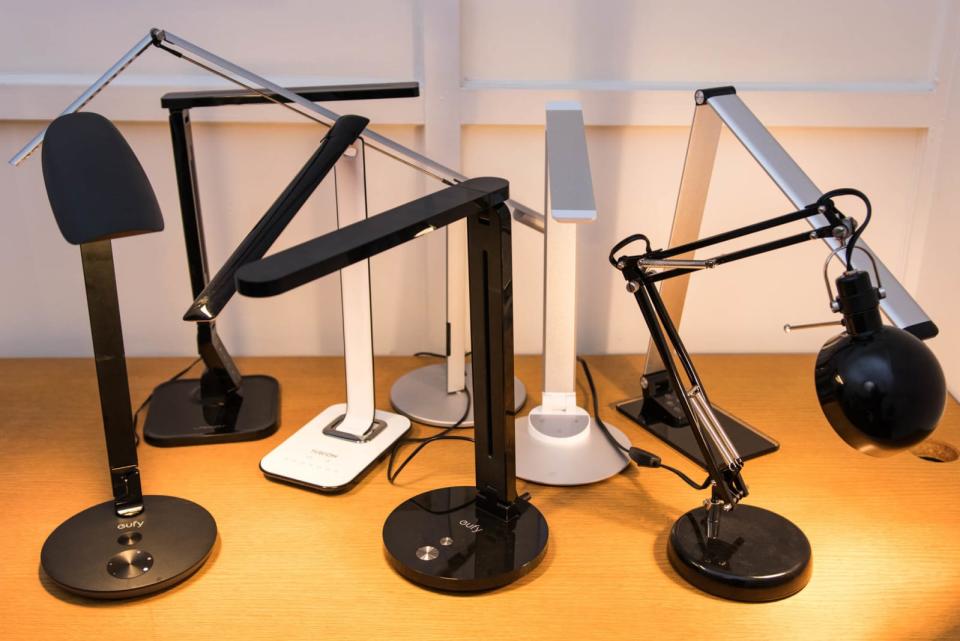
To compare LED desk lamps, we used them as we would in our day-to-day routines. We assembled them and eliminated any lamps that were exceptionally difficult to set up, that weren't adjustable, or that caused glare on computer screens or paper due to exposed LED diodes or panels that weren't adequately covered by the lamp's shade.
We used the remaining lamps at a desk during work, and then at night to read books and magazines, experimenting with each lamp's range of color temperatures and brightness settings. To further compare that range, we lined the lamps up side by side to cycle through settings. On lamps with USB-charging ports, we also plugged in an iPhone to test for charge.
Our pick: TaoTronics LED Eye-caring Desk Lamp (TT-DL13)
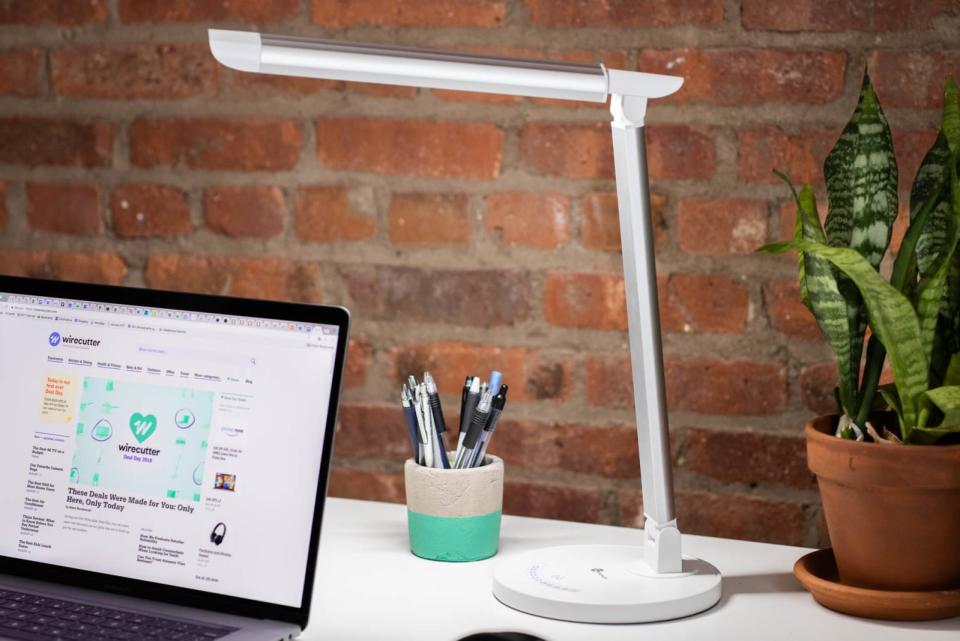
The TaoTronics LED Eye-caring Desk Lamp (TT-DL13) is the best lamp we've found for task work, and it's the one we'd pick to accentuate a home-office desk or task table. It has the widest range of brightness and color temperatures of the lamps we tested, making it the most versatile for different moods or times of day, and its frosted light panel diffuses light and prevents glare better than the competition. And its adjustability stands out, thanks to a pivoting head that focuses light at an angle and an arm that reaches over tasks and swivels on the lamp's base. (The lamp itself is nearly indistinguishable from our runner-up pick, the Fully Lumen, which costs twice as much unless you're buying the Lumen in a bundle with our recommended standing desk.)
The most important thing in a task lamp is the capability to adjust the lighting to your needs. The Eye-caring lamp makes it easy to select your preferred color temperature or brightness by tapping a button or swiping along an arc of backlit circles, respectively, on a touch-sensitive panel on the base. The seven brightness levels max out at 420 lumens, which is above our 400-lumen minimum and, in our testing, bright enough for everyday desk tasks. (TaoTronics makes a few other brighter lamps, but we found the Eye-caring to have the best combination of color temperature and brightness options, physical adjustability, and aesthetic appeal.)
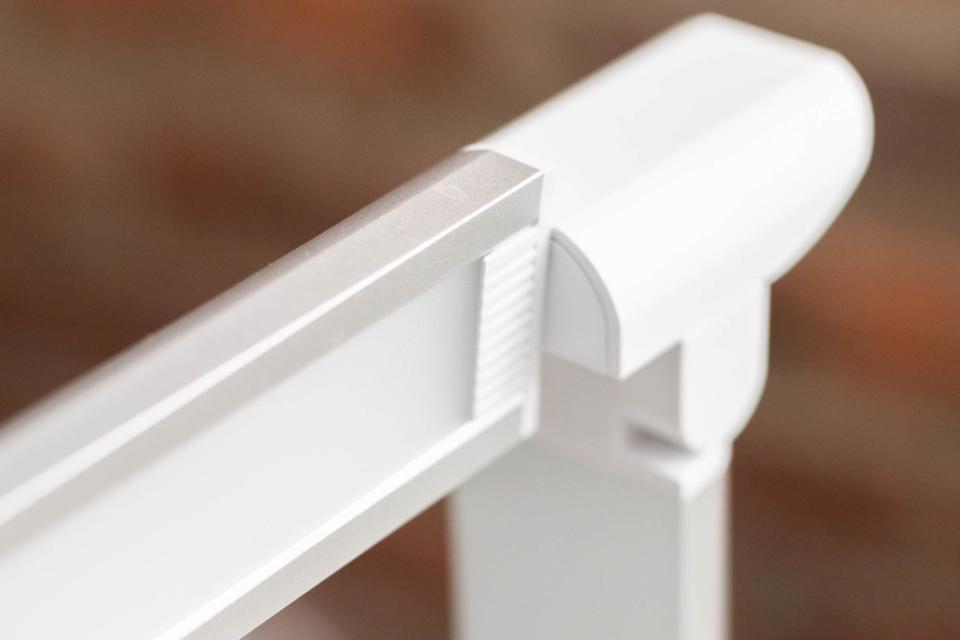
The Eye-caring has a frosted panel that covers the LED diodes to effectively prevent glare, with a hood that fully covers the top of the light panel. The lamp also never flickered during our testing, casting a pleasing, uniform light.
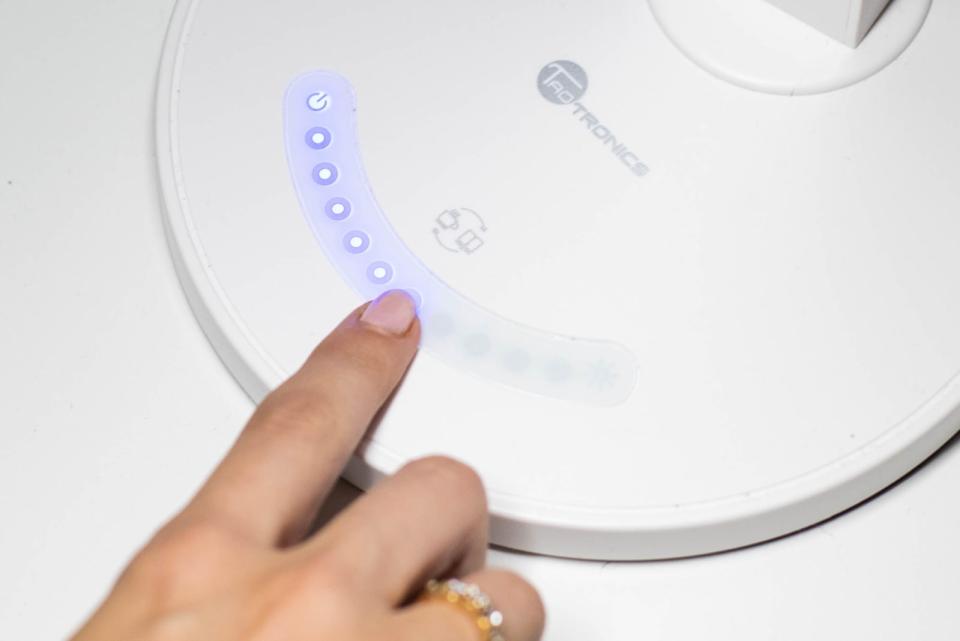
The Eye-caring is also one of the most physically adjustable lamps we tested, so it's easy to customize the position of the light to your needs. The head can pivot around its axis and tilt 135 degrees up and down; the body of the lamp can swivel from side to side on the base; and the main "neck" can lean forward and back to reach over papers or other reading material. While reading, I preferred to tilt the lamp over my book for direct light; when using my laptop, I liked to pivot the head up toward the ceiling, illuminating my workspace with reflected light.
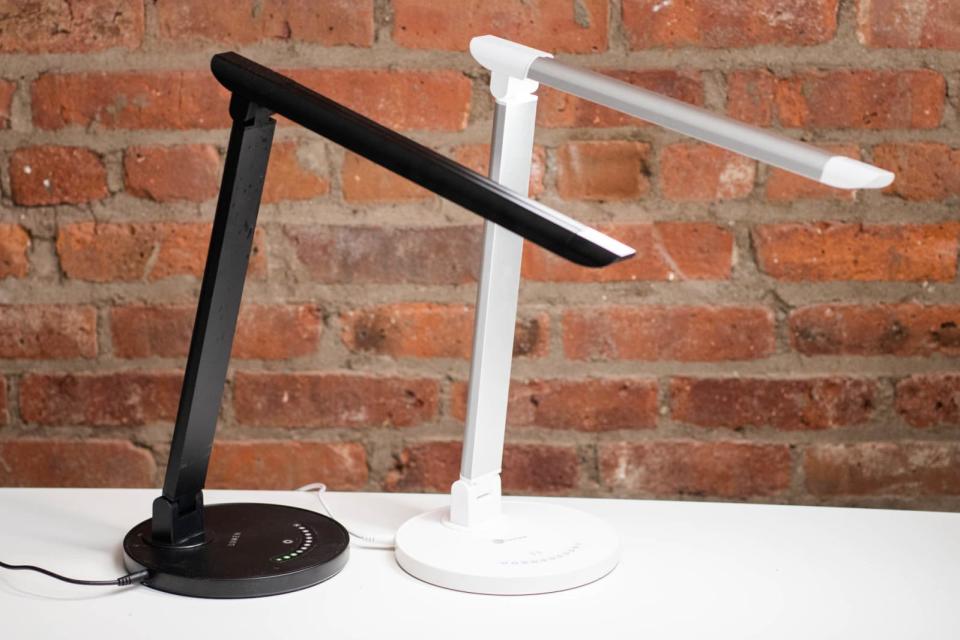
The Eye-caring comes with a one-year warranty, but its non-replaceable bulb should last for 25 years, according to TaoTronics's site. Because LEDs lose brightness over time rather than suddenly going out, we will continue to test the lamp to see how long it takes for the LEDs to fade.
Compared with the many similar bar-style lamps we tested, we like the Eye-caring's design: Rounded edges make the lamp look tasteful, the touch panel is simple without many icons, and the lamp comes in black or white. The lamp also has a 5 V / 1 A USB charging port on the back of its base for a phone or tablet. Although the Eye-caring isn't as design-oriented as more expensive lamps from specialty lighting stores, it has the best blend of style and functionality, at the best price, of all the lamps we tested.
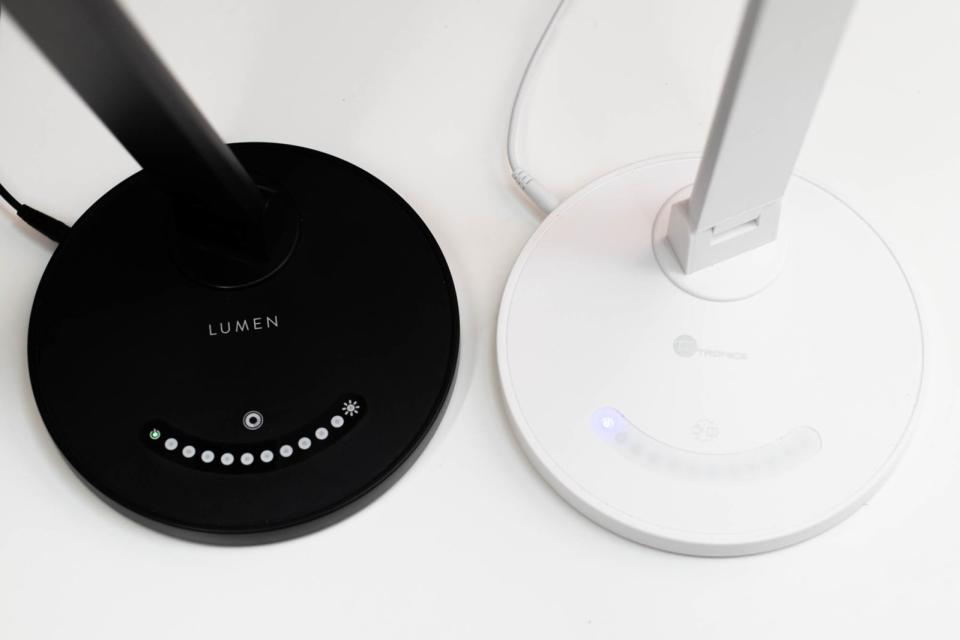
Flaws but not dealbreakers
Our experts say that some people, including older people or those working on very detail-oriented tasks, may need up to 800 lumens of brightness, and the Eye-caring maxes out at 410. Though that should be fine for most people, check out the Competition section if you need a brighter lamp.
The Eye-caring has a color-rendering index of 80, which, as we mention above, is typical of LEDs. (CRI is an average that's measured on a scale, and can fluctuate based on the color temperature and brightness selected; a given rating is a minimum CRI.) If you're working with photos or other tasks where color accuracy is important, this CRI may not be high enough, but you otherwise likely won't notice a difference compared with higher-CRI lamps.
Runner-up: Fully Lumen LED Desk Lamp
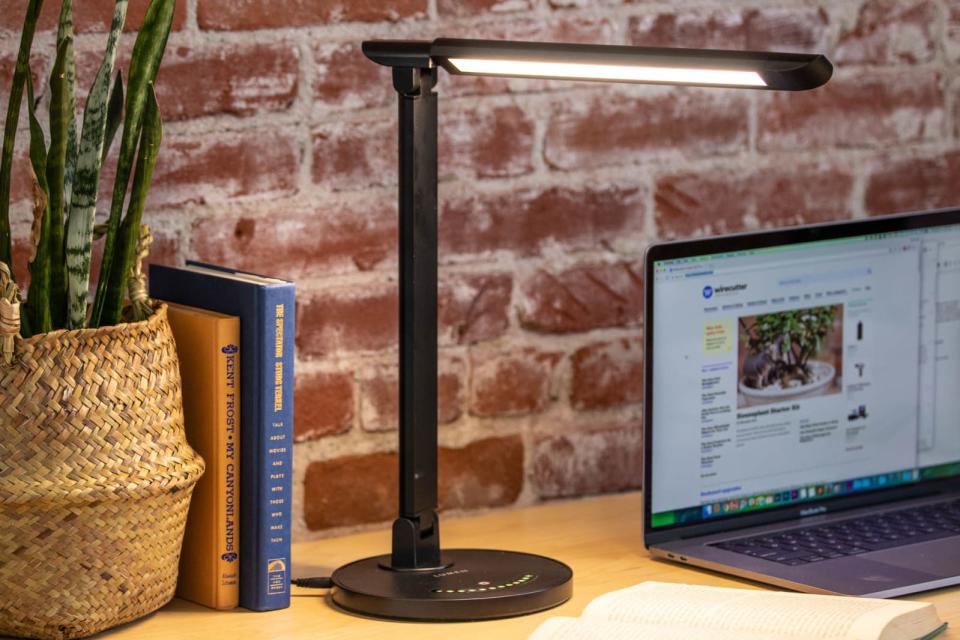
The Fully Lumen LED Desk Lamp is virtually identical to the TaoTronics Eye-caring Lamp. It has just the same brightness and color-temperature options, the same adjustability, and the same design other than the logo and slightly different designs on the touch-panel labels. In fact, Fully told us that the company worked with TaoTronics to design the lamp. The only real difference is that the Lumen weighs a half pound more, which Fully says is for added stability (though we barely noticed a difference in stability in our testing). But the Lumen costs twice as much as the TaoTronics, so we recommend it only if the TaoTronics is unavailable or if you're purchasing it alongside our standing desk pick, also from Fully, which drops the lamp's price to $35.
With seven brightness levels and five color-temperature modes, the Lumen has the same customization options as the Eye-caring. Fully's site says that the lamp tops out at 410 lumens, while the TaoTronics claims 420 lumens, but the difference wasn't noticeable in our testing. The Fully has the same CRI of 80 and the same touch-sensitive control panel.
The Fully looks almost exactly like the Eye-caring, and its construction feels the same. It has a similar frosted panel that prevents glare, no matter how you position the pivoting head. It also has a neck that easily extends from the base, a head that swivels to focus light, and a 5 V / 1 A USB charging port on the back of the base for a phone or tablet. It also has the same one-year warranty. We do prefer the Lumen's even-subtler touch-sensitive panel, which has a slightly different icon to indicate brightness or color-temperature changes, and yellow-green backlighting compared with the Eye-caring's brighter blue backlight, but these differences are minor—and not worth paying twice as much as the TaoTronics to get.
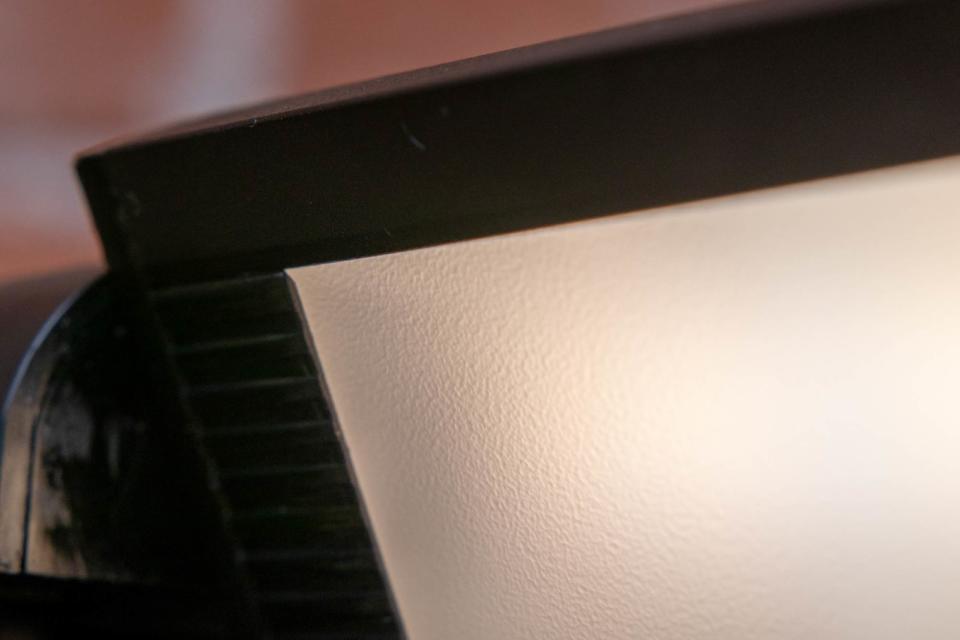
Also great: IKEA Forså
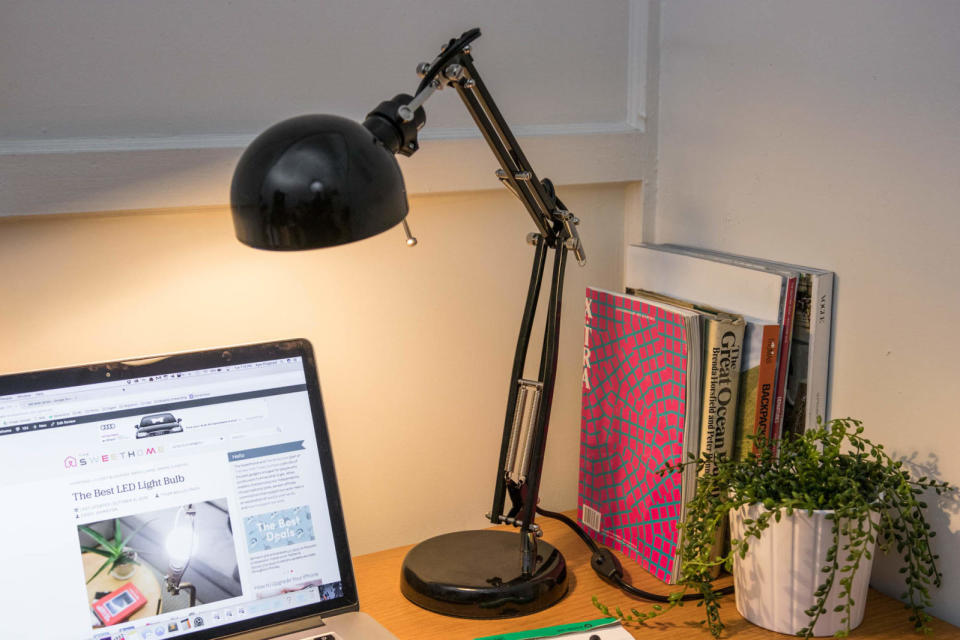
For people who want an affordable desk lamp and don't need specific brightness or color-temperature options, the IKEA Forså is a great choice. Unlike the rest of the LED lamps we tested, the Forså just has an on/off switch for a bulb you can purchase separately at the brightness and color temperature of your choosing. The budget-friendly, architect-style lamp is highly adjustable, so you can easily position it over your workspace. The lamp comes in four colors: nickel-plated, black, blue, and green. (For customers in California, the Forså is priced about $5 higher and packaged differently because lamps in California must be sold with bulbs.)
We tested the Forså with IKEA's recommended 6-watt light bulb that's equivalent to about 400 lumens. The Forså provides a softer, more diffuse beam of light than our other picks, and you can control the direction of the light by adjusting the Forså's hood. If you need more light, or a different light temperature, you can always choose a different bulb, up to 40 watts (again, watts measure a bulb's energy use, while a lumen rating denotes its brightness). And because the Forså's bulb is replaceable, you can swap it out when it starts to dim instead of having to replace the whole lamp (although it will likely take a very long time for the bulb to die).
The Forså has a more adjustable head and neck than any lamp we tested, making it the easiest to get light exactly where you need it. Because the lamp's two arms have a joint in the middle, you can easily position light closer to or farther from what you're working on. You also get about 18 inches of height adjustability. Thanks to its sturdy metal base, you can use a lighter touch to adjust this one: Adjusting the hood takes just one hand, although you may still need to hold down the base when extending the lower arm of the lamp backward and forward.
Like most IKEA products, you'll have to assemble the Forså yourself, but it takes only a few minutes (making it a small IKEA miracle). Though the Forså lacks the brightness and color-temperature capabilities of the other LED lamps we tested, we like it as an attractive, budget-priced desk lamp that's available locally at an IKEA store. It's covered under IKEA's one-year warranty.
The competition
The Lumiy Lightblade 1500S is highly rated by Amazon customers, but after our testing, it went out of stock. However, as of this latest update, the lamp is available again on Amazon. The company doesn't provide brightness measurements in lumens, but the lamp should put out about 1,500 lumens of light (the measurement is in lux, which measures lumens per square meter, or light in a certain area). That's higher than our picks, but in real-world use, the lamp didn't seem all that much brighter. Because its CRI rating is higher than 93, it might be a better choice for artists and photographers. However, the Lumiy's panel also creates some dots of light because individual LED diodes are slightly visible.
In our experience, IKEA's LED lamps look great but don't necessarily function as well as others. The IKEA Ypperlig has an adjustable head and a base that rotates, but the neck doesn't extend. With this setup, it's hard to angle the lamp over your work at a desk, but it might work on a nightstand.
We like the sleek Varidesk LED TaskLamp, which can stand alone on the included base or clamp onto a desk to save space. But this lamp has only three brightness levels that max out at 340 lumens, and it offers just three color temperatures.
At 420 lumens, the TaoTronics Minimalist LED Desk Lamp (TT-DL19) is a great LED desk lamp that has a frosted panel for reducing glare, a single 1-amp USB charging port, and a sleek, brushed-silver finish, but it doesn't offer as many brightness levels as our picks. Its head also doesn't pivot, making it less adjustable than our picks—we couldn't angle the head toward a monitor or laptop, only extend it.
The Lampat Dimmable Desk Lamp is an inexpensive lamp that's highly rated on Amazon, but the LED panel created the most glare of any lamp we tested due to bright, exposed diodes that are not covered by a frosted panel. This lamp works fine but seems like it's of poorer quality than our picks—its rectangular base, red-backlit touch panel, and cheaper-looking black plastic make its design feel a little dated.
We tried the spendy Koncept Equo based on the recommendations of the lighting designers we interviewed, who like this brand and urged us to test lamps with as long a warranty as possible (the Equo has a five-year warranty). We also wanted to see if a $200 lamp was that much better than a $50 lamp. It wasn't. Although the Equo does look great, its LED diodes aren't recessed, causing glare, and though you can pivot the lamp's head, doing so may have you looking into that glare because there's no frosted panel covering the diodes. Although you can buy the lamp in either of two color temperatures—3,500 K or 4,000 K—each model has only three brightness levels.
The Turcom RelaxaLight is one of the brightest lamps we tested at 1,000 lumens; it also has a wide range of brightnesses and color temperatures, and it's reasonably priced. It's a fine lamp, but not one we'd buy. Although the head on the lamp pivots and the panel is frosted, the LED diodes are still visible beneath the panel. When you change the color-temperature setting, some diodes change colors while others don't, creating a distracting pattern.
We tested an updated version of the Newhouse Lighting 9W LED Executive Desk Lamp, but it has limited availability online. With 630 lumens of brightness and three color-temperature modes, it's another fine lamp, but one with a smaller range of color temperatures than any adjustable LED lamp we tested.
This guide may have been updated by Wirecutter. To see the current recommendation, please go here.
When readers choose to buy Wirecutter's independently chosen editorial picks, Wirecutter and Engadget may earn affiliate commissions.
